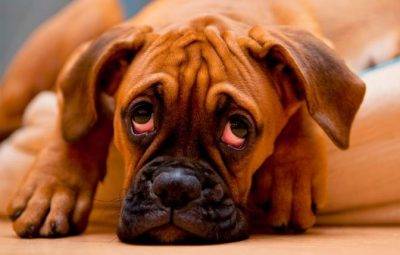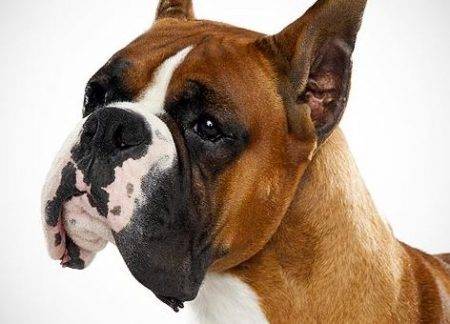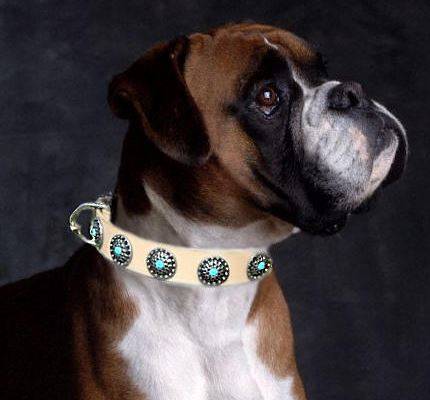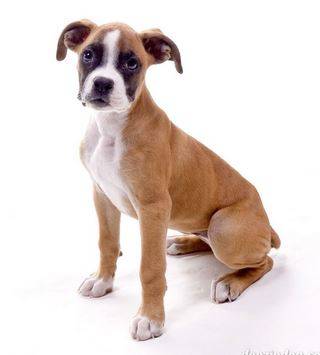Boxer Dog Breed Information Guide
(adsbygoogle = window.adsbygoogle || []).push({});
Boxer dog breed information profile includes history, appearance, size, temperament, lifespan, health, training of Boxer dogs and puppies.
Thinking about adding a Boxer dog or puppy to your family?
Check out our Boxer Adoption Listings and Boxer Dog Breeders directory.
All About Boxer Dogs and Puppies
Boxer Dog Breed Facts
Origin: Germany
Height: 21.5 – 23.5 inches at the shoulder for females and 22 -25 inches high at the shoulder for males
Weight: 55-70 pounds
Exercise Needs: High
Grooming Needs: Low
Life Expectancy: 12-14 years average
Good With Kids: Yes
Trainability: Can be headstrong and stubborn
Common Misspellings: Boxxer, Boxxers
Alternate Names: German Boxer, Brindle Boxer
The Boxer is an energetic, fun loving dog whose ancestors are German mastiff-type dogs, the Bullenbeiszer and Barenbeiszer. The dogs were bred indiscriminately. Over time, the Bullenbeiszer became smaller and was called the Brabanter.
These strong and agile dogs were used by the elite for hunting wild boar, deer and bear. The dogs’ ears were cropped to avoid being injured by the game animals. Their strong jaws enabled them to seize and hold the prey for the hunter, while his recessed nose allowed him to breathe.
In about 1830 the Brabanter was bred with the English Bulldog ancestor. These dogs were white in color and often used by cattle dealers to round up livestock. Because of their ability to learn tricks easily, and their clownish nature, they were also popular circus dogs.
By the early 1900’s the Boxer was well established in North America and was soon recognized by the American Kennel Club. Since that time, the handsome Boxer has grown steadily in popularity to become one of the most widely adopted pets in America.
Boxer History
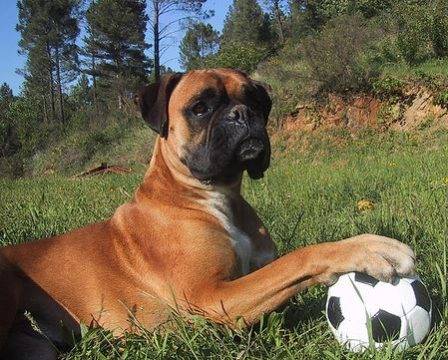 The modern Boxer has evolved from two breeds of extinct European dogs. The larger Danziger Bullenbeiser and the Brabenter Bullenbeiser were both used as a hunting companions and assistants. These dogs were used to chase after prey, take them down and await the hunter’s arrival.
The modern Boxer has evolved from two breeds of extinct European dogs. The larger Danziger Bullenbeiser and the Brabenter Bullenbeiser were both used as a hunting companions and assistants. These dogs were used to chase after prey, take them down and await the hunter’s arrival.
In the 1830’s the boxer was put to work in slaughterhouses as a cattle dog. Soon thereafter, The German Boxer Klub was formed in the 1860’s and the breed subsequently flourished. Around the turn of the century, Boxers were introduced to the US and in 1904 the AKC breed standard was established.
The commonly held belief is that the English name “Boxer” was given to the breed because of their tendency to use their front paws when fighting or playing. There are other theories to explain the origin of the name. “Boxer” was a name commonly given to dogs and it may be that the breed name was taken from the first known of the species. Still another theory suggests that the name ‘Boxer’ came from the German word “Boxl,” which was his common name in the slaughterhouses of Germany.
Throughout the years, Boxers were often used for police work and it was believed that a darker color dog would be more difficult to see at night. During WWI they were used as military dogs and were utilized as pack dogs, attack dogs, guard dogs and messengers. Soldiers returning home from WWII brought Boxers with them and they quickly became popular family pets, show dogs and guard dogs.
Boxer Appearance
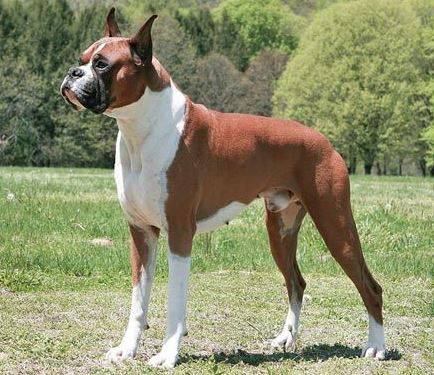 The Boxer has a powerful, well-muscled body with a shiny coat that snugly fits the body. The jaw is square-muzzled with a powerful bite; the lower jaw extends beyond the upper. The Boxer’s hearing is keen making them excellent guard dogs.
The Boxer has a powerful, well-muscled body with a shiny coat that snugly fits the body. The jaw is square-muzzled with a powerful bite; the lower jaw extends beyond the upper. The Boxer’s hearing is keen making them excellent guard dogs.
The coat of the Boxer is fawn or brindle with a white underbelly and white on the front feet or all four feet. “Flashy” Boxers have white fur reaching up to the neck or face. “Plain” Boxers have white fur on their toes or a small splash of white fur on the chest.
Fawn covers a range of colors from yellow or beige to various shades of red. Brindle is a tiger-like stripe of black against a fawn background. Some brindle Boxers have more black than fawn in the stripes and are called “reverse brindle.” So-called “white” boxers actually have a base coat of fawn or brindle with excessive white markings.
AKC standards do not allow for more than one-third of the Boxer’s coat to be white for show. White Boxers are not allowed in AKC show dog competitions but you will often find them in obedience and agility trials. Boxers do not carry a gene for solid black coat color and no purebred Boxer will be black. Boxers intended for the show ring were once required to have docked tail and ears, but in 2005 AKC standards changed to allow a description of undocked ears.
The first registered Boxer AKC championship was awarded in 1915. In 1949 Bang Away was awarded Best in Show at Westminster and went on to win 121 show awards in a six-year period. Bang Away became famous and appeared on the front of many popular magazines including Life and Esquire. The Boxer became very popular in the US due to his success and is still one of the ten most popular breeds of dog.
Boxer Temperament
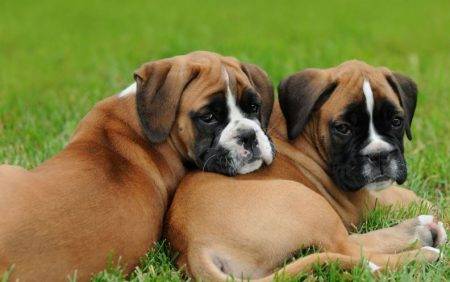 Boxers once had a reputation for being aggressive, and were often used for dog fighting, but modern Boxers are affectionate, playful and loyal. Aggression is not acceptable in a Boxer, and dogs with this trait should not be bred. Boxers are highly intelligent and quick learners but they can be obstinate.
Boxers once had a reputation for being aggressive, and were often used for dog fighting, but modern Boxers are affectionate, playful and loyal. Aggression is not acceptable in a Boxer, and dogs with this trait should not be bred. Boxers are highly intelligent and quick learners but they can be obstinate.
Firm, consistent training from an early age by a dominant owner is vital with this breed. When properly socialized Boxers will get along with other household pets, although Boxers of the same sex in the same household tend to fight among themselves to display dominance.
If the owner wants to have two Boxers in the family it is best to have one of each sex. Fond of children, Boxers are patient with their rowdy antics. They bond closely with their family and it is their nature to protect their family and home. Fearless, instinctive guard dogs, Boxers are wary of strange people and pets but will welcome known visitors with enthusiasm.
Boxer Exercise Info
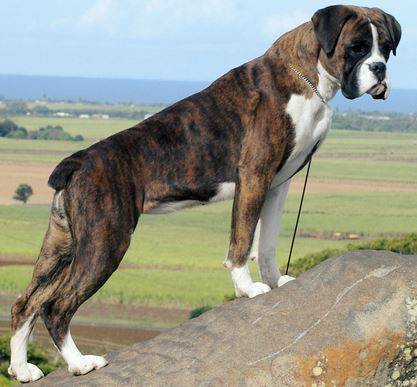 Boxers will adapt to almost any home environment as long as they have people around. Rambunctious indoors, they will do fine in an apartment but require lots of regular daily outdoor exercise or long brisk walks. A house with a mid-sized, fenced yard is best for your Boxer to romp.
Boxers will adapt to almost any home environment as long as they have people around. Rambunctious indoors, they will do fine in an apartment but require lots of regular daily outdoor exercise or long brisk walks. A house with a mid-sized, fenced yard is best for your Boxer to romp.
Being a working breed and Boxers need physical activity and mental stimulation to keep them occupied and out of mischief. Their short coats allow them to chill quickly and they should be indoor dogs. They do better in moderate climates and do not tolerate temperature extremes well.
Boxer Grooming Info
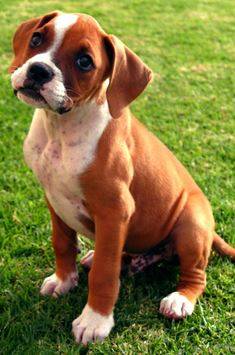 Grooming your Boxer is a breeze when compared to other mid-sized dogs. His very short coat means that a weekly brush is all your Boxer will need to keep his coat gleaming and chic. The Boxer will accept baths, but do be prepared for him to unexpectedly spring for freedom.
Grooming your Boxer is a breeze when compared to other mid-sized dogs. His very short coat means that a weekly brush is all your Boxer will need to keep his coat gleaming and chic. The Boxer will accept baths, but do be prepared for him to unexpectedly spring for freedom.
It is wise to use cotton balls in his ears to prevent infection. Finally, there are dozens of doggie shampoos on the market, but be sure to select one with low fragrance and rinse carefully and thoroughly.
Boxer Training Info
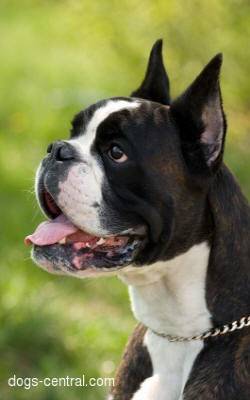 The Boxer can be a very easy individual to train, provided they believe that they need that training that you’re trying to give them. Notoriously stubborn and keenly intelligent, these dogs seem to have a will of their own and react adversely to a strong hand.
The Boxer can be a very easy individual to train, provided they believe that they need that training that you’re trying to give them. Notoriously stubborn and keenly intelligent, these dogs seem to have a will of their own and react adversely to a strong hand.
Persistence is essential when dealing with the Boxer (if you break routine and let him get away with something, rest assured that he will make the most of the opportunity). Positive reinforcement and regular routines are essential to the training of a Boxer dog and many owners report great success with clicker training these magnificent dogs.
Obedience training is essential for your Boxer, not only to teach him basic commands, but also to promote good socialization with other people and animals.
Taking the time to teach your dog properly will not only make things easier for you, as his handler, but also easier for him as it will help him to better understand what, exactly, it is that you want. Boxers are, above all else, dogs that thrive on companionship and praise. Treat him well and there’s nothing your Boxer puppy wouldn’t do for you.
Boxer Health Info
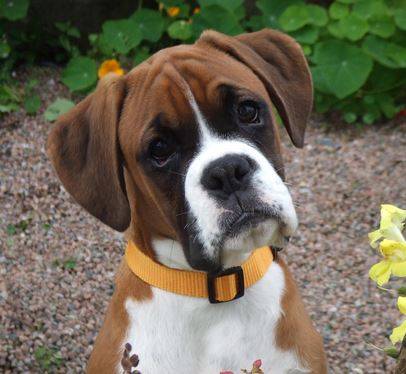 The life expectancy of the Boxer is 11 to 14 years. The adult male will stand 22 to 25 inches and weigh 60 to 70 pounds. Females are slightly smaller. The main health concern with the breed is that they are more likely to get cancer than other breeds once they reach the age of eight years.
The life expectancy of the Boxer is 11 to 14 years. The adult male will stand 22 to 25 inches and weigh 60 to 70 pounds. Females are slightly smaller. The main health concern with the breed is that they are more likely to get cancer than other breeds once they reach the age of eight years.
Other major health concerns include sub-aortic stenosis, cardiomyopathy and hip dysplasia. They are also prone to epilepsy, allergies and skin conditions. They have a tendency toward sensitive stomachs and excessive flatulence and a proper diet is essential.
White Boxers tend to have more health problems than fawn or brindle Boxers and have a high tendency toward deafness. Many experts do not recommend breeding White Boxers with other Boxers of any color to avoid increasing the prevalence of hereditary defects within the gene pool.
At one time many breeders would euthanize white puppies but now the common practice is to spay or neuter the puppy and place it with a family as a companion animal.
Is a Boxer the Right Breed For You?
 A dog lover who chooses a Boxer as a pet should consider the activity level and lifestyle of the family. Boxers will not do well in a family where they will be left alone all day while their people are at work. Training must begin at an early age to teach appropriate behavior.
A dog lover who chooses a Boxer as a pet should consider the activity level and lifestyle of the family. Boxers will not do well in a family where they will be left alone all day while their people are at work. Training must begin at an early age to teach appropriate behavior.
They need consistent physical and mental exercise to keep from becoming bored and destructive. If you are willing and able to give the Boxer the time he needs you will have a loyal, loving, lively and intelligent companion.

